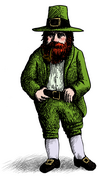
Back بوابة:مناسبات Arabic Portail:Fêtes et traditions French Portale:Festività Italian Портал:Празници Macedonian Portal:Feriados Portuguese Portal:Sărbători Romanian Портал:Бәйрәмнәр Tatar Portal:Amaholide Zulu
| Main page | Calendar | Categories |
Introduction

A holiday is a day or other period of time set aside for festivals or recreation. Public holidays are set by public authorities and vary by state or region. Religious holidays are set by religious organisations for their members and are often also observed as public holidays in religious majority countries. Some religious holidays, such as Christmas, have become secularised by part or all of those who observe them. In addition to secularisation, many holidays have become commercialised due to the growth of industry.
Holidays can be thematic, celebrating or commemorating particular groups, events, or ideas, or non-thematic, days of rest that do not have any particular meaning. In Commonwealth English, the term can refer to any period of rest from work, such as vacations or school holidays. In American English, the holidays typically refers to the period from Thanksgiving to New Year's (late November to January 1), which contains many important holidays in American culture. (Full article...)
Selected article

May Day is May 1, and refers to any of several holidays celebrated on this day. May 1 was a traditional springtime holiday in many pre-Christian European pagan cultures, and many elements of these holidays are still celebrated on May 1 today, such as the Maypole. "May Day" also refers to various socialist and labor movement celebrations conducted on May 1, unrelated to the traditional celebrations, to commemorate the Haymarket Riot of 1886 and the international socialist movement generally.
The earliest May Day celebrations appeared in pre-Christian Europe, as in the Celtic celebration of Beltane, and the Walpurgis Night of the Germanic countries. Although the pagan-oriented celebrations faded as Europe became Christianised, a more secular version of the holiday continued to be observed in the schools and churches of Europe well into the 20th century. In this form, May Day may be best known for its tradition of dancing the Maypole and crowning of the Queen of the May. Today many Neopagans, especially Wiccans, celebrate reconstructed versions of the old pagan holidays on May 1.
Selected biography

In Irish mythology, a leprechaun is a type of male faerie said to inhabit the island of Ireland. They are a class of "faerie folk" associated in Irish mythology and folklore, as with all faeries, with the Tuatha Dé Danann and other quasi-historical races said to have inhabited Ireland before the arrival of the Celts. Leprechauns and other creatures of Irish mythology are often associated with "faerie forts" or "faerie rings" — often the sites of ancient earthworks or drumlins. They are said to be very rich, having many treasure crocks buried during war-time. According to legend, if anyone keeps an eye fixed upon one, he cannot escape, but the moment the eye is withdrawn he vanishes.
Things you can do
 |
Here are some tasks awaiting attention:
|
Selected image
Selected quote
| “ | We hold these truths to be self-evident, that all men are created equal, that they are endowed by their Creator with certain inalienable Rights, that among these are Life, Liberty and the pursuit of Happiness. | ” |
| — United States Declaration of Independence | ||
Related portals
WikiProjects
Major topics
Holidays - Anniversaries - Civic holidays - Federal holidays - Hallmark holidays - Heroes' Day - National holidays - Observances - Holidays by Country - Victory Days
Lists: Christmas carols - Christmas dishes - Hindu festivals - Holidays by country - Objects dropped on New Year's Eve - Winter festivals
Religious festivals: Buddhist festivals - Christian festivals - Islamic festivals - Neopagan holidays - Hindu festivals - Jain festivals - Jewish holidays - Roman festivals
Secular holidays: April Fools' - Armed Forces Day - Boss's Day - Children's Day - Cinco de Mayo - Commonwealth Day - Earth Day - Father's Day - Grandparents' Day - Halloween - HumanLight - Labor Day - May Day - Mother's Day - Naadam - Pi Day - Presidents' Day - Spring break - Teachers' Day - Thanksgiving - Yom Yerushalayim
Winter holidays: Chinese New Year - Christmas - Dōngzhì - Eid ul-Adha - Festivus - Groundhog Day - Hanukkah - Kwanzaa - New Year's Eve - Shab-e Chelle - Sol Invictus - Twelfth Night - Valentine's - Winter Solstice - Yule
Associated Wikimedia
The following Wikimedia Foundation sister projects provide more on this subject:
-
Commons
Free media repository -
Wikibooks
Free textbooks and manuals -
Wikidata
Free knowledge base -
Wikinews
Free-content news -
Wikiquote
Collection of quotations -
Wikisource
Free-content library -
Wikiversity
Free learning tools -
Wiktionary
Dictionary and thesaurus
© MMXXIII Rich X Search. We shall prevail. All rights reserved. Rich X Search










